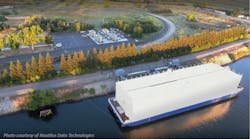Why Sustainability Matters in Data Center Site Selection
PUE is no longer the only metric customers, local governments, and other stakeholders care about when it comes to data center site selection. This launches our article series on the role that sustainability should play in the development and deployment of data centers.
Get the full report
Data centers have seen a long history of changes designed to improve their economies. When “green” became a watchword of corporate purchasing, the need to develop data center technologies and operational techniques that allowed companies to point to their success in making their data centers “greener” became much more important. When PUE became an industry standard, businesses could point to the increased efficiencies of their data center operations as proof that they were making significant strides along the path to greater energy efficiency.
Data center operators continued to develop metrics to drill down on how their facilities used energy and determine the efficiencies of their operations vis-a-vis the workloads running in their data centers. These metrics became selling points for the data centers for privately owned and operated facilities and colocation providers.
But through more visibility and the industry’s evolution, the focus now pivots from simply evaluating single metrics to approaching the data center from the scope of sustainability and overall efficiency. Driving factors include public attention on data center energy use and increased pressure as many countries, such as Singapore and Ireland, began moratoriums; now, scrutiny persists as data center water usage is brought to light in the public forum. Luckily, efficiency is not only better for the environment but better for business. Creating a more cohesive measurement of the infrastructure also means a way to understand its implications on the business and completely shifts the narrative. Now the measurement of a data center as a good neighbor and business benefit is no longer easily codified into metrics such as PUE, but also how good a corporate citizen the data center is, how well it fits into the neighborhood, and what benefits the operation of a data center facility could bring to the community where it is operating.
No longer operating in a vacuum where the technology impact and relatively simple energy consumption are the primary metrics in evaluating where data centers are located, the change to finding a path towards sustainability is from the ground up. It should be a major criterion for where and how data centers are developed and deployed.
Nautilus Data Centers takes the ground-up approach to design, building, and operating data centers. Taking a foundationally sustainable approach, they have easily met the demands of the most stringent environmental requirements in the world.
Why does sustainability impact data center site selection?
The decision to build a fundamentally sustainable data center literally needs to start with the ground. Unlike energy efficiency and technologies that improve workload and performance features such as power density and power distribution, a sustainable data center needs to start with a site that meets the criteria established for a sustainable data center site. It’s rarely, if ever, that something can be added after the fact.
You will need to put together your list of needs and requirements with the sustainability lens coloring all your decisions because every aspect of the data center is affected by site selection: power source, water supply, job availability, community inclusion, and the potential for brownfield usage. Through an adjustment in the approach at the beginning of the process, you can achieve both data center goals and business objectives.
Considering the data center as a whole and not a series of discrete issues
There is a tendency to consider each aspect of a data center as somewhat independent from the rest, a legacy approach from when facilities and IT maintained an often adversarial relationship. The idea we are going to build a large building with power and cooling and fill it full of server racks is still one the general public holds, but the industry has, for the most part, moved beyond. Data centers are most often purpose-driven now. They are built for specific reasons to support specific business goals. As the hybrid model has become more commonplace in business IT, company data centers may be smaller, edge-focused, or entirely outsourced to a colocation facility, where a business problem gets the amount of space it needs to handle the appropriate IT workloads, be it a rack, a cage, or an entire data hall.
If the cloud model has done anything, it has driven the data center user to understand better what they need to get from their data center to support their IT workload. Businesses are learning to understand the overall impact of their data center investment and how it impacts not only their operational issues but everything from business flexibility to corporate responsibility.
There is a rise in the conversation around the focus on energy efficiency in the data center: flexibility, scalability, and a focus on operational expense drive the model forward.
Taking a more holistic approach to data center design means treating your data center model the same way you look at the cloud. The market factors that drove the growth of cloud services now come into play when you approach site selection and design for your data centers. It’s no longer just a reflection of the capital expenditures necessary to meet business needs; operational expenses now take on a more critical role. Reliability has long been a watchword of the data center, driving everything from meeting SLAs to the necessary design criteria of achieving five-nines of uptime, which have traditionally been the goal for all data centers. Now, however, a robust and reliable data center, including the critical infrastructure, is the starting point for a model that is as scalable as possible. It needs to support business growth and flexibility, able to support the business needs in rapidly changing to meet market demands and changes. Data centers must be agile enough to support business growth with no impact on operation or reliability and flexible enough to support rapidly changing market demands and changes.
A quick search on the topic of the holistic data center will get you dozens of lists and how-tos on the concept, but it now tends to all boil down to a more holistic operational model built on top of the traditional focuses on availability. There is a rise in the conversation around the focus on energy efficiency in the data center: flexibility, scalability, and a focus on operational expense drive the model forward.
Download the entire paper, “Sustainability in Data Center Site Selection“ courtesy of Nautilus Data Technologies, to learn more. In our next article, we’ll take a look at why sustainability and ROI go hand in hand.
About the Author



